|
IOWA PROFILE
| ||||||
|
| ||||||
|
MONUMENTS | ||||||

| ||||||
|
The Freedom Flame
A Monument to all Iowans Who Contributed to the World War II Effort - to Those Men and Women Who Fought in Battles Around the World as Well as Those Who Labored Here at Home.
In the fall of 1994, a group of Iowa veterans of WWII discussed the fact that there was no monument on the capitol grounds commemorating the heroic efforts and sacrifices of Iowans who contributed to the victory in this monumental struggle. They determined to do something about it. A committee of veterans was formed, the necessary funds were raised, and planning proceeded. On November 11, 1996, the monument was dedicated and given to the people of Iowa. The purpose of the Freedom Flame Monument is two-fold: 1) to honor all of those who served so valiantly during World War II - veterans and civilians alike; and 2) to provide posterity with knowledge about the compelling reason for the USA's involvement in the war - the preservation of freedom around the world. There are four major components included in the monument. The Freedom Walk is a walkway with major events of the war engraved in granite, leading to the Freedom Flame and Wall of Memories. Included near the beginning of the walk is the Pearl Harbor memorial which has been incorporated into the Freedom Walk and now serves as an impressive reminder of the event which brought the United States into conflict. The Map of the World is a seventy-foot-in-diameter inlaid map of the world which forms the floor surrounding the Freedom Flame. Colored maps showing the major battles of the war are mounted on concrete stands on either side of the floor map. The Freedom Flame, towering thirty-five feet into the sky, is the dramatic centerpiece, a five-component stainless steel stylized sculpture of a flame. In the center is a beam of light visible from more than a mile away at night. The Wall of Memories is a 65 foot-long semicircular wall which serves as a fitting backdrop for the Freedom Flame. On the Wall's center panel are pictures of the nine Iowa servicemen who were awarded their country's highest honor, the Congressional Medal of Honor. The surrounding panels show various reminders of the impact that the war had on service men and women, and on civilians at home - personal letters, newspaper articles, cartoon, mementos and other memorabilia of the time. The Wall of Memories stimulates visitors to reflect on the human aspects of the war and to ponder the enormous effect of the conflict on the lives of all Iowans. | ||||||
|
| |||||||||
| Soldiers and Sailors'
Monument
The most striking monument on the Statehouse grounds is the granite shaft rising 145 feet, erected to the memory of the soldiers and sailors of the Civil War. The heroic bronze figure "Victory" is predominant, while at the base there are four groups representing different branches of the military or naval service, and numerous historical plaques and medallion portraits of typical soldiers. The original design was by Harriet A. Ketcham, and work was commenced in 1894. | 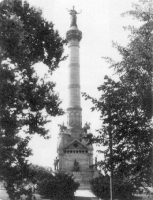
| ||||||||
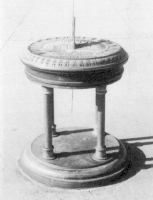
|
Grand Army of the Republic Sundial
This bronze sundial was dedicated to Union veterans of the Civil War during their 1938 GAR encampment in Des Moines. Nearly three million Union soldiers fought during the Civil War. In 1938, an estimated 5,000 were still living. More than 100 of these veterans, most over 90 years old, attended the encampment. Dr. D.W. Morehouse, then president and astronomy professor at Drake University, installed and adjusted the timepiece. Since that time, the sundial has kept accurate Central and Eastern Standard Time. | ||||||||
|
Spanish-American War Veterans Memorial
The Iowa Volunteer Troop from Camp McKinley raised this memorial to honor Iowans who voluntarily served in the Spanish-American War, the Philippine Insurrection, and the China Relief Expedition. A bronze cross fronts the large granite marker, listing each Iowa regiment that fought in the engagement from 1898 to 1902. Leslie P. Shaw, Iowa's governor during the Spanish-American War, is also honored. | 
| ||||||||
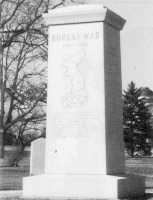
|
Korean War Memorial
The drive for a Korean War monument began in 1984 when students from a Des Moines school wrote Governor Terry E. Branstad asking why Korean War veterans did not have a memorial. The monument includes a 14-foot tall central obelisk and eight 6-foot tall tablets that tell the story of the Korean War with words, pictures, and maps engraved in the granite. Erected on a grassy area south of the Statehouse, the monument was dedicated by Governor Branstad on May 28, 1989. | ||||||||
|
Vietnam Veterans' Memorial
On Memorial Day, 1984, Governor Terry E. Branstad
and former Governor Robert D. Ray dedicated the Vietnam Veterans' Memorial.
The memorial is dedicated to the 115,000 young Iowans who served during
the Vietnam Era, and has the names of 855 Iowans who lost their lives
during | 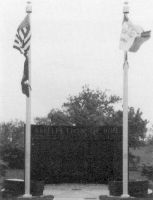
| ||||||||
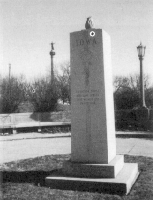
|
Veterans of Foreign Wars Memorial
A red granite "eternal flame" burns atop this ten-foot high white granite memorial. Erected in 1976, the monument was an American bicentennial gift from Iowa chapters of the Veterans of Foreign Wars (VFW) and their Ladies Auxiliary to honor all Americans who have fought overseas. | ||||||||
|
| ||||||||
|
Iowa Peace Officer Memorial
The idea of the Peace Officer Memorial was originally conceived by Raymond Baker, police chief of Cedar Rapids. Governor Terry E. Branstad dedicated this memorial in May 1985 to all Iowa peace officers who gave their lives while protecting the rights of Iowa's citizens. Located north of the Lucas Building, the memorial's three outer forms symbolize three levels of law enforcement: city, county, and state. Pads connect these forms to the memorial's center pinnacle which represents the officers' supreme sacrifice. The original design was created by Richard Webb, an Ames police officer. | 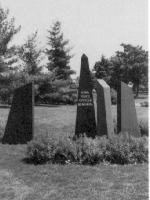
| |||||||
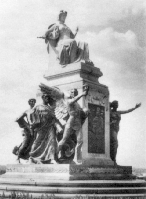
|
Allison Monument
In 1917, friends of Senator William B. Allison, citizens and school children of Iowa, and the state legislature raised this memorial. A pivotal figure in Iowa's Republican party, Allison (1829-1908) represented Iowa in Congress for 43 years. He was twice a candidate for the presidential nomination of his party and was close associate of every United States president from Abraham Lincoln to Theodore Roosevelt. The monument is an allegorical design of heroic dimensions, depicting civic duties in the public service, and is encompassed by a flower bed.
| |||||||
|
Christopher Columbus Memorial
The Italian-American community in Iowa donated this monument to the state in 1938. It was financed by individual subscriptions. A bronze bust of Christopher Columbus, the Italian discoverer of America, rests between classical granite pillars. Anthony L. Sarcone of Des Moines, an Italian-American publisher and civic leader, dedicated 20 years to the project. | 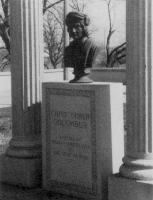
| |||||||
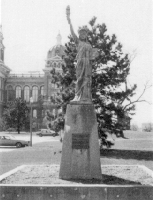
|
Statue of Liberty
In 1950, the Tall Corn (now mid-Iowa) Council of the Boy Scouts of America donated this miniture Statue of Liberty to the State of Iowa as part of their annual service project. | |||||||
|
Japanese Bell and Bell House
After typhoons in 1959 severely damaged crops, homes, and farmlands of Yamanashi prefecture in Japan, citizens of Iowa generously sent breeding hogs and feed corn to aid that district. This program began a friendship culminating in a sister-state relationship, the first of its kind between the United States and Japan. As a sign of their appreciation, the citizens of Yamanashi presented this monument to Iowa in 1962. The 2,000 pound bell of peace and friendship and the structure that houses it were made in Japan. | 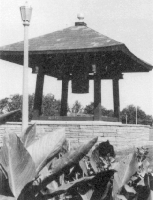
| |||||||

|
Lincoln and Tad Monument
A statewide penny drive among school children raised money to finance this monument. It is the only representation of Lincoln depicting him in his role as a father. Dedicated in 1961, this sculpture was initiated two years earlier to honor the 150th anniversary of Lincoln's birth. Fred Torrey, a renowed Lincoln sculptor, designed and created the statue. Mable Torrey, his wife and a specialist in child sculpture, did the work on Tad. The artists used a photograph of the president and his son as a guide. | |||||||